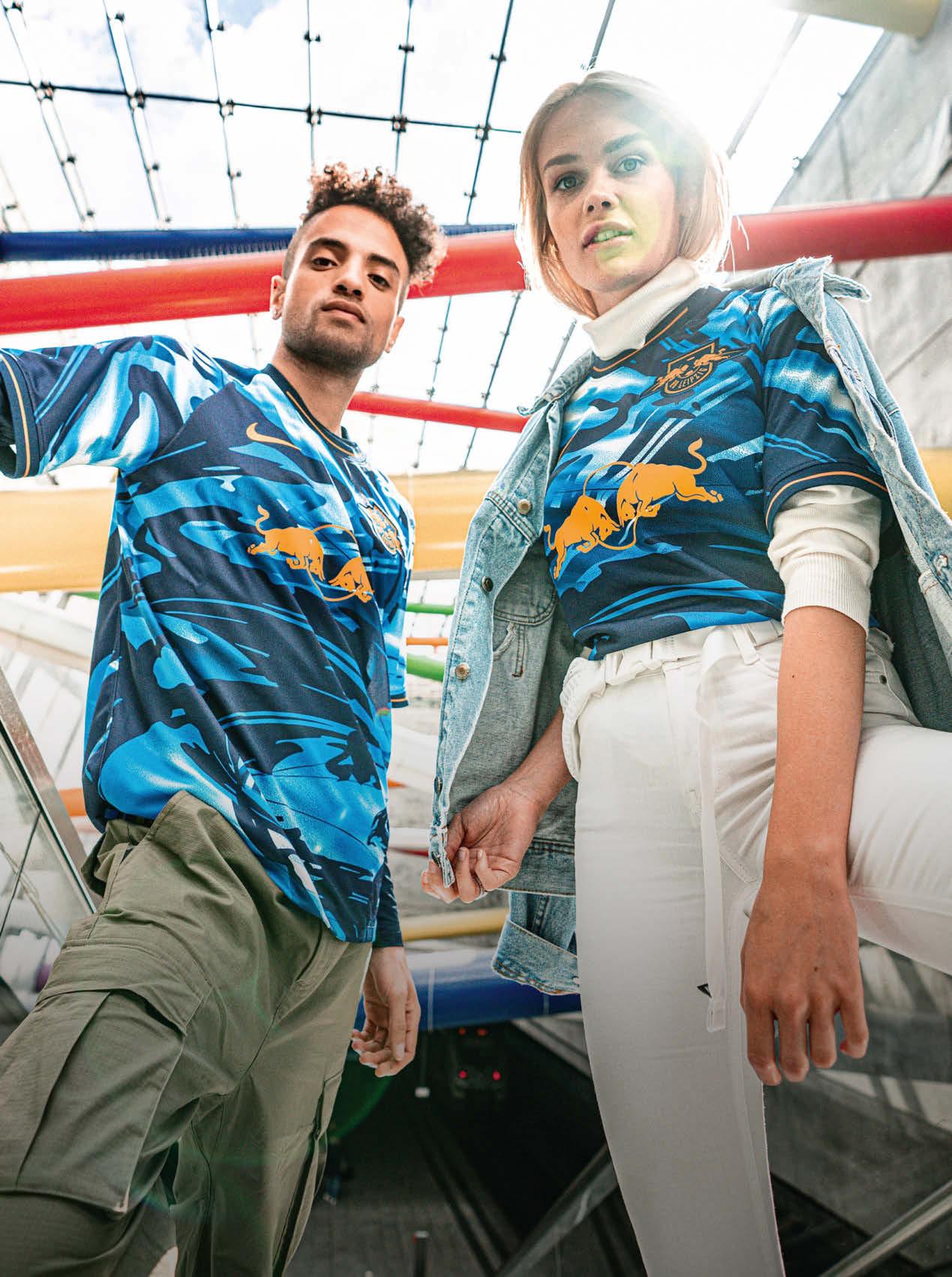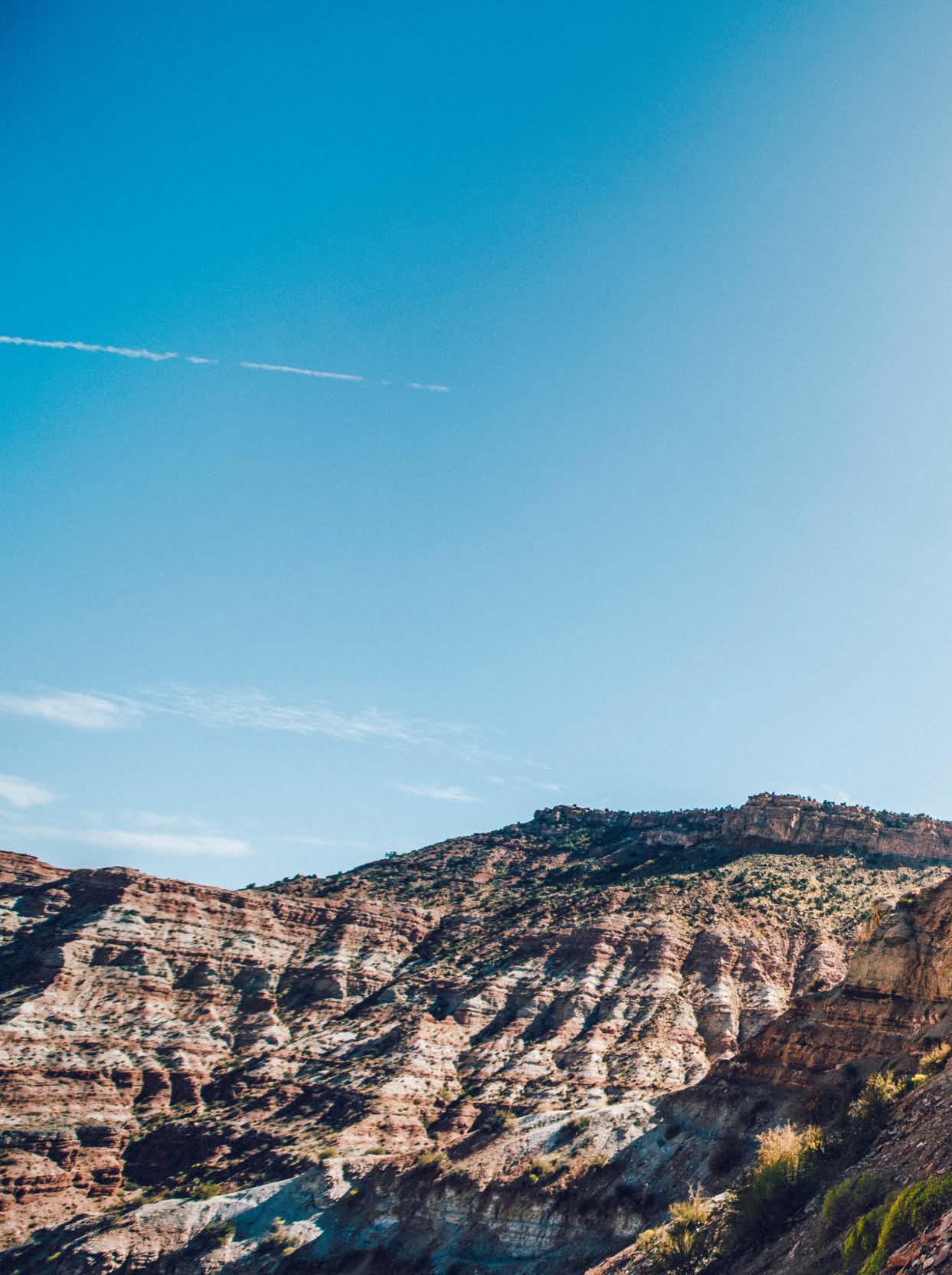
47 minute read
Ghetts
TIME TO SHINE
East London rapper GHETTS has been putting in the work for almost two decades, and now fnally it’s paying off. Here, he talks about fghting conformity, the power of self-belief, and how ditching his ego was the key to success
Future’s bright: Ghetts’ moving third album, Conflict of Interest, is an early contender for ‘Best of 2021’ lists
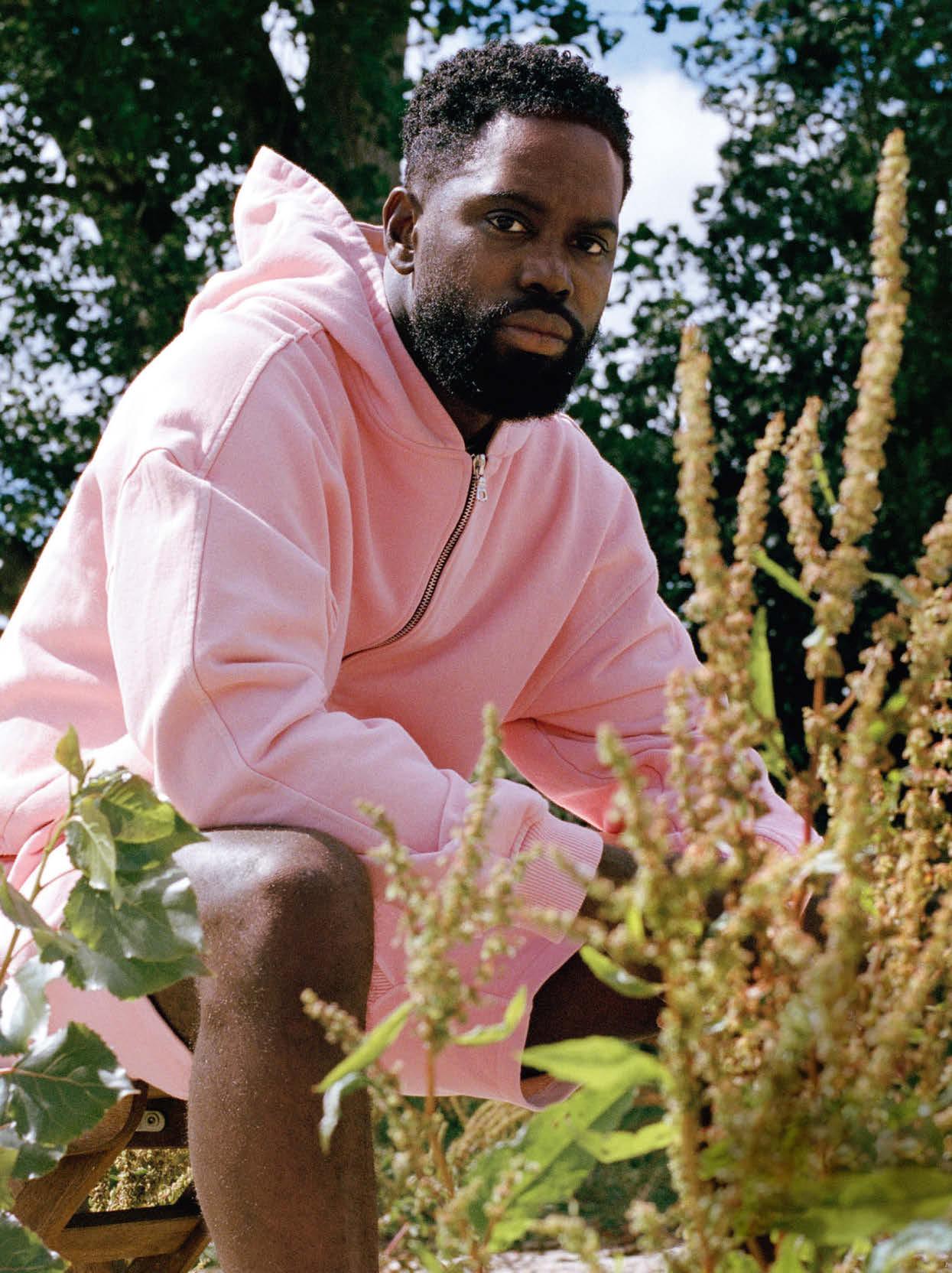
P
laying the long game isn’t for everyone. But, for Ghetts, patience and determination have been key components of a career built to last. Our first taste of the British rapper’s raw, whip-smart wordplay and magnetic charm came in 2005, when – under the name Ghetto – he guested on the track Typical Me by Kano, a fellow member of east London collective NASTY Crew. That 42-second introduction signalled the arrival of a grime heavyweight in the making – even if it was to be a slow and steady ascent to prominence.
Born in Plaistow, east London, Ghetts – real name Justin Clarke – began taking his career as a rapper seriously soon after being released from prison for a series of minor car-crime offences in 2003. His debut mixtape, 2000 & Life, was released at the tail end of 2005, followed two years later by his second, the acclaimed Ghetto Gospel. Packed with big ideas and diverse subject matter, conceptually the mixtape was ahead of its time in the grime world and highlighted the depth and range of the then 22-year-old artist. Known as the MC’s MC, for years Ghetts stood by and watched as a number of his grime contemporaries broke into the mainstream and were lauded as the leaders of the new and exciting cultural uprising he was helping to create.
But finally the agile wordsmith is enjoying his own moment in the sun. Ghetts has been nominated for awards – including a place on the Best Contemporary Song shortlist at the Ivor Novellos for Black Rose, a rousing celebration of the strength and beauty of Black men and women – and has worked with artists such as Ed Sheeran, Stormzy and Emeli Sandé; he can also count the likes of Drake and Kanye West as fans. Then, earlier this year, he scored a first UK top five hit with his critically acclaimed third album, Conflict of Interest.
Although this path has been longer for Ghetts than for others, he says that the journey has taught him lessons on what true success means. According to the now 36-year-old, humbling himself and choosing to be thankful has contributed to him making the best music of his entire career and, in turn, is the reason why he’s now earning the acclaim he so desperately hungered for.
the red bulletin: Compared with many other artists, your success has been a long time coming…
ghetts: It really has. And it’s been a bit overwhelming, if I’m honest. For a long time, I felt like my back was against the wall when it came to making music and putting it out, like I had to constantly prove so many people wrong. Whereas recently it’s been the opposite; I’m now at a place where I’m having to prove people right – but that’s not a bad thing.
Why do you think people are connecting with you more now than they did before?
I think my songwriting is the best it’s ever been. I’m at a point where I feel like I’m becoming more of a wellrounded artist. As a lyricist, you can sometimes go overboard and just rap a bunch of bars, but you’ve got to know when to put your foot on the brake and when to take it off. That was something I had to teach myself. I don’t think I would be having the success I am now if I hadn’t got rid of my ego.
Was that hard to do?
At times, yeah. But there’s no room for ego when you’re trying to be great. I can definitely say I find it easier to do within music than in real life. When you’re having an argument with your partner and you swear you’re in the right, it’s harder to say, “You know what, babe? I’m in the wrong.” But it shouldn’t be that way. Removing your ego from both work settings and reality settings is really important – at least for me.
What made you want to get rid of it?
I started to see things that I don’t like about other people creeping into myself. There was a time when I was super

Dropping knowledge: Ghetts’ redemptive life and career experiences make him a powerful role model for kids growing up today
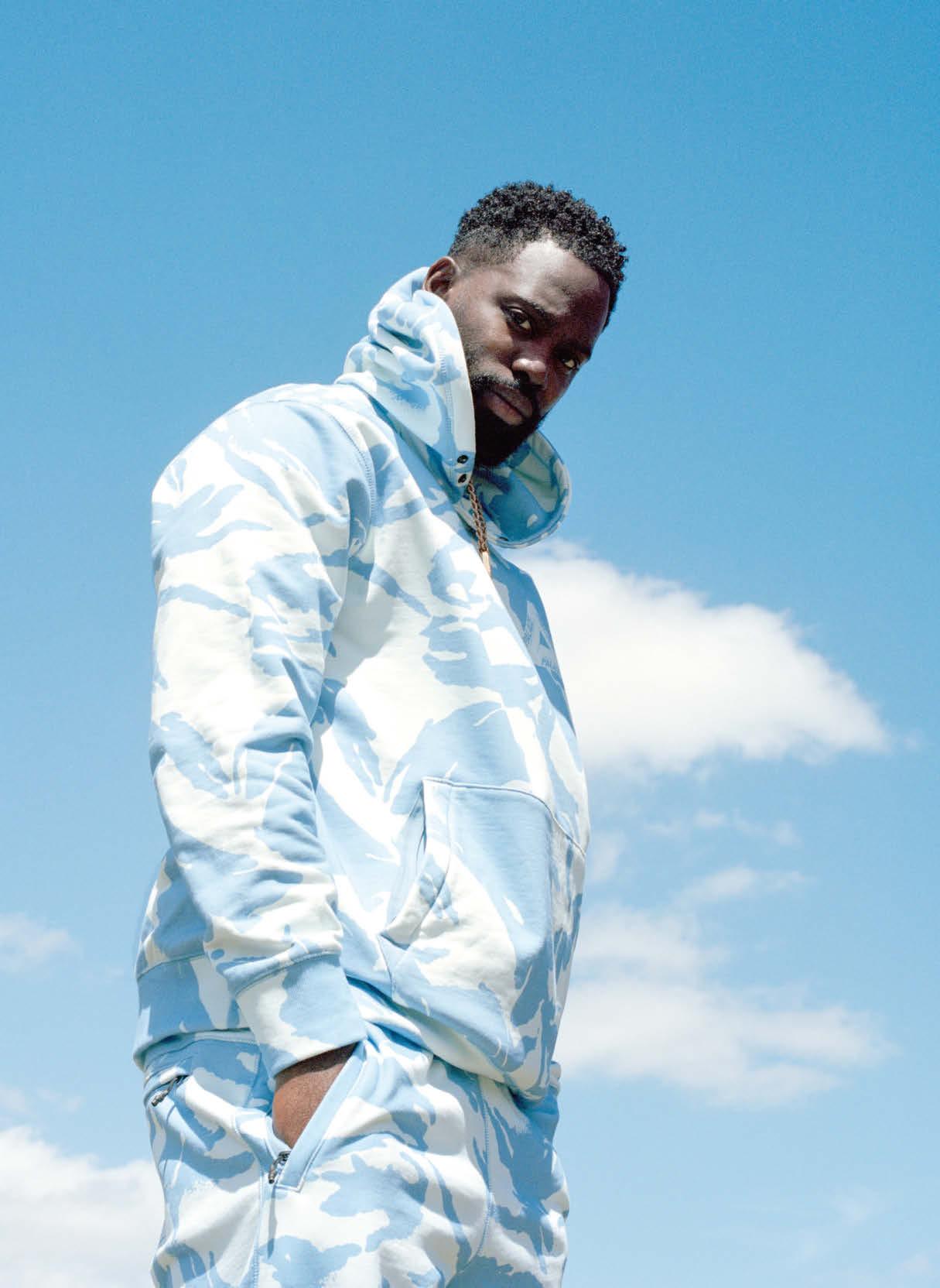
ungrateful. I couldn’t see all the opportunities and blessings I had. I was looking at everyone else’s life and couldn’t see what was going on in my own. I was always thinking that what I had wasn’t enough.
When you were released from prison in 2003, having served time as a juvenile, what was it that prevented you from going back?
It was the support I had from my family while I was in there; it acts as a deterrent. Some of the worst things we do in our lives happen because we feel like no one cares. It’s an overwhelming feeling. A lot of people commit suicide because they feel like nobody gives a shit. So when you feel like somebody cares, it can act as a deterrent and it can really help you through some of the hardest times in your life. That’s why in the video for Proud Family [released as a single last December] I included the scene when young Justin leaves prison and is greeted by his mum. There’s a lot of layered thinking in it.
On that same track, you rap: “I’ve been who I see all these youngers becoming.” Knowing what you know now, what advice would you give your younger self?
I’d point out the opportunities. I’d tell myself you gotta be grateful for every step you take, whether big or small. Every bit of progression is amazing and should be celebrated. I’d tell myself to be thankful and to look at how far I’ve come. I want [today’s young people] to know that although I might not have ever been in as deep as them, I still understand what it is they’re going through. I know to them I sound like the OG who’s lecturing them about staying on the straight and narrow, but I’ve seen enough to know that 99.9 per cent of the time the street life only ends one of two ways: death or jail.
Would you say your days in prison were some of your darkest?
They weren’t great, but they weren’t my darkest. My darkest days were when
I made [2008 mixtape] Freedom of Speech. I really wasn’t in a good place when I put that project together.
In what way?
It was around that same time I was struggling to see my blessings and it was beginning to bleed into my music. If you listen to Ghetto Gospel, which came out [the year] before, I stepped out of my comfort zone and created something with a lot of depth in it. But the feedback I was getting at the time wasn’t what I wanted to hear. So I decided to conform to the underground with Freedom of Speech. I felt like people would understand that better.
That’s unusual. It’s not often you hear about artists conforming to the underground…
Way more people conform to an underground sound than they do a mainstream one, trust me. It’s because they’re scared to be who they really are outside of what they’re perceived to be, especially if it’s working for them.
It can’t have been easy putting the demands of the listener ahead of your own creative needs…
It wasn’t. It made me feel really conflicted, and that’s what eventually led to the title of my [latest] album, Conflict of Interest. I got halfway through making it and realised I was a very conflicted human being. I had a real self-aware moment where I decided I couldn’t risk not including all the qualities that make me who I am. I wasn’t going to present just one side of myself. We’re all humans, and on a dayto-day basis most of us are conflicted. I just so happen to be capturing some of these moments on record, so it’s my job to make the public understand it, even if sometimes it sounds like we’re contradicting ourselves.
Have there been times where you’ve felt pressure to conform to the mainstream, too, as you’ve watched your peers experience huge success?
Yeah, I used to have that feeling all the time. These days, everyone’s screaming culture, culture, culture. But I remember very clearly a time when it was less about culture and more about looking for that hit, something made specifically to be played on radio or at a festival. One of my old managers used to say stuff like that to me. Like, “We need to get in the studio with this person or that person.” But I never went through with it. I didn’t feel like I needed to.
Where did you get that self-belief?
Every step I take seems impossible to the people around me, but because I’ve made so many of them already I know the next step’s a real possibility. I prayed for the person I am today. I was in a prison cell, telling the inmates that the person I am now was who I was gonna be. Very few people believed me. I was telling the governor that I’d never be coming back to jail, but he hears that every day. It doesn’t mean anything to him – they’re just words. So I look at every step like that very first one. Everything is possible to me.
Have you had to make sacrifices to get where you are now? If so, what has been the biggest?
My time. I never have enough of it to do other things. I spoke to someone recently who I hadn’t seen in a while and I was really apologetic about it. He was like, “Nah, it’s fine. I understand that you’ve been busy.” I thought to myself, “That’s not really an excuse, because tomorrow’s never promised.” Time is moving so fast, and because I’m so focused on one area I keep sacrificing it. I’m always questioning whether or not my career is important enough for me to continue sacrificing my time.
And is it?
That’s hard to answer. I know what I want in life. I know what I want for my kids, and what I’ve got to do to achieve it. But at the same time it’s breaking bonds that could be made stronger. It’s a tricky one, but I’m gonna continue to work on it and work on myself. Ghetts will be touring the UK this November. For tickets, go to ghetts.co.uk
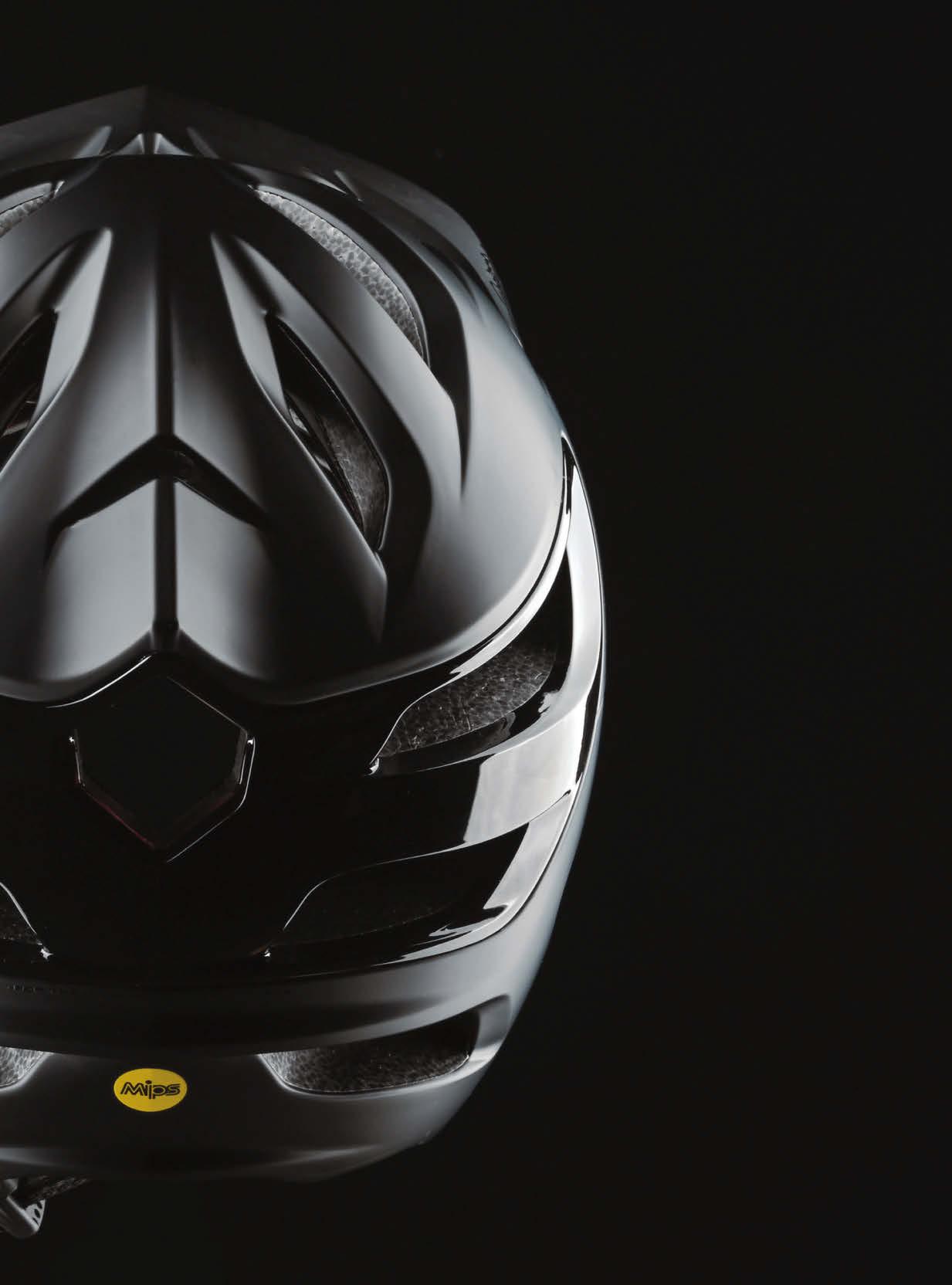
VENTURE
Enhance, equip, and experience your best life
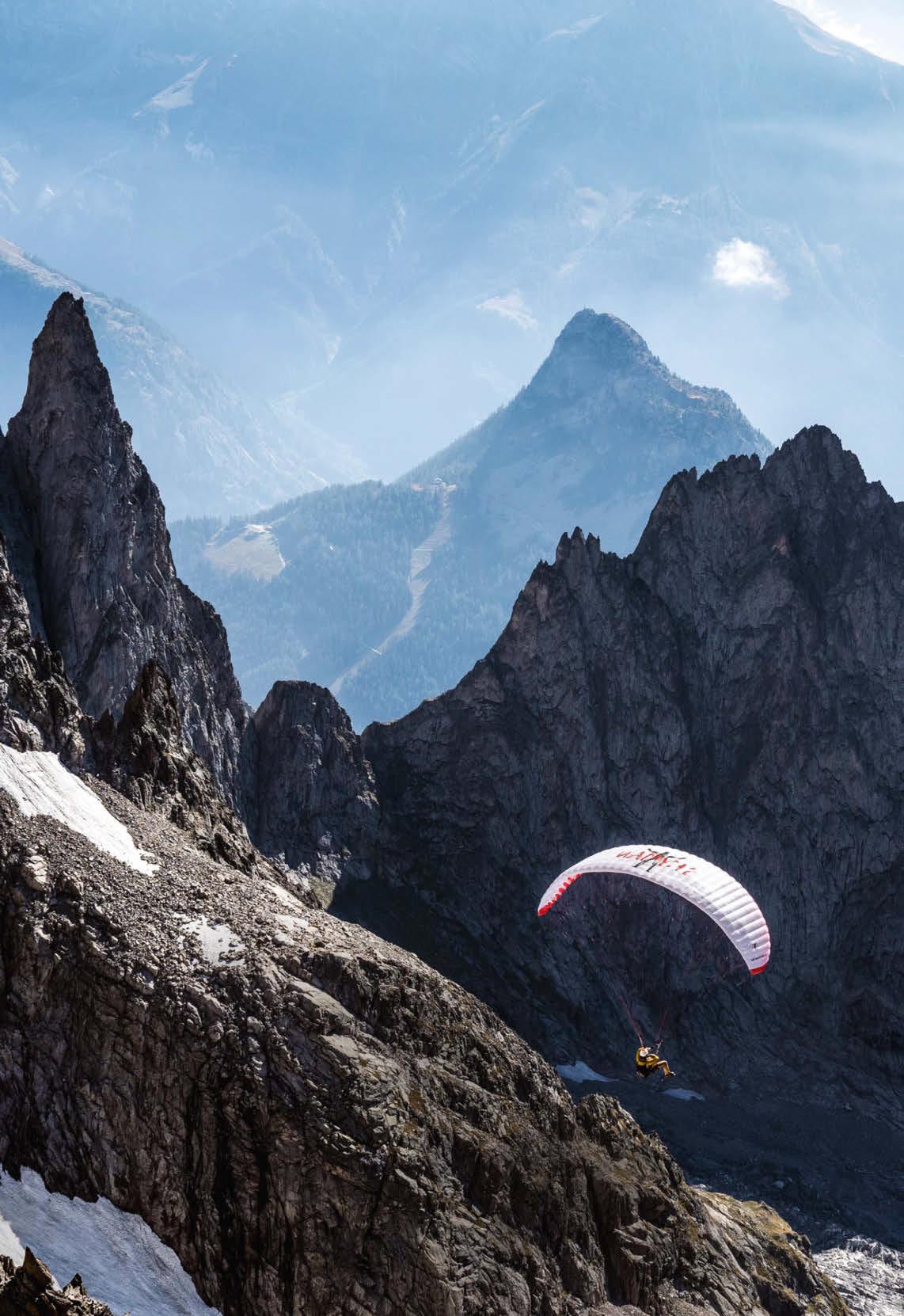
PARA-ALPINISM
Mont Blanc, France-Italy border
Calum Muskett, climber and mountain guide
Snow crunches underfoot as I make the final few steps along the narrow snow ridge leading to the summit of Mont Blanc, the highest peak in western Europe. Cloud shrouds the French side of the mountain as a chill breeze freezes my eyelashes. It’s 7am on September 1, 2019, and the region’s regular summer paragliding ban has just been lifted. A wave of nausea hits me as I unpack my bag – I feel physically beaten by the effort to reach the summit. More than 3,500m below me lies the Chamonix Valley. From here, the route down Mont Blanc would normally be long, arduous and risky, crossing glaciers and rock walls, but I won’t be making the descent on foot – I’m going to fly it.
I’ve been climbing mountains ever since 2006, when I served an apprenticeship on the crags and cliffs of my native North Wales. These days, as a professional climber and mountain guide, I follow the seasons, dividing my time between the mountains of Snowdonia and the Giffre Valley in the French Alps. Two years ago, I learned to paraglide, which opened up new horizons for me. An ascent of Mont Blanc would normally take three days and involve two cable cars and a train ride; now I can leave Chamonix in the early hours, climb the mountain, and be back down for a second breakfast.
There’s something liberating about flying – there’s that release of pressure from committing a launch where you have to get everything just right, feet dangling improbably over the abyss as you cheat evolution and soar with the birds. After 10 minutes of untangling frost-covered lines and laying out my canopy, I’m away, swooping down to Italy in the cool morning air, thankful that I don’t have to walk any further, and ready for my morning cappuccino pick-me-up in the café that sits next to the landing field.
Para-alpinism, as it is known in France, is becoming an increasingly popular pastime. As the name suggests, this is a combination of paragliding and alpine mountaineering, and the European Alps – with their limited flight restrictions and excellent infrastructure – are particularly well geared towards the pursuit. The concept isn’t new – pioneers such as the Frenchman Jean-Marc Boivin were launching off many of the world’s highest summits some four

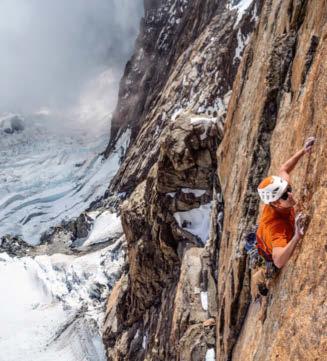

Peak time: Muskett ascends a snow ridge to reach the Eccles bivouac hut in the early morning

Where to go
Location:
Chamonix Valley
Nearest airport:
Geneva
Transport:
Six cable car systems
Altitude:
More than 4,000m, with 11 main summits in the Mont Blanc massif
Seasonal info:
The massif is restricted in July and August France
Italy
decades ago. This early era of the sport culminated in Boivin’s successful flight off Everest in 1988; since then, the technology of – and interest in –paragliding has shifted towards crosscountry flying, where the performance of wings has been orientated towards improving the glide ratio and lift of canopies. The current cross-country world record stands at a straight distance of 564km, set by three Brazilian pilots in 2016, while the highest flight ever recorded was established that same year by Frenchman Antoine Girard, who soared above Broad Peak in Pakistan at an astonishing 8,157m.
The early pioneers of para-alpinism would shoulder huge packs weighing in excess of 12kg (that’s without factoring in any of the mountaineering equipment required), making climb-and-fly missions impractical, to say the least. Recent improvements in technology have provided new canopy types consisting of just a single ‘mono-skin’ layer rather than the conventional double layering system with air cells. These new wings weigh as little as 1kg, pack into a midsized stuff sack, and have an ultra-light sit-harness. This step-change in technology has given the sport a new lease of life. But fast and light paraalpinism is just one strand of the sport; the real appeal for me is what you can achieve when you introduce technical climbing, where conventional descents by abseiling and down-climbing can be both lengthy and dangerous.
It’s September 2020 and, together with my friends Paul and Jake, I’m back

Soar point: (above) Muskett flies above the heavily crevassed Glacier du Brouillard; (below) approaching the landing field in the Val Veny, Italy
on Mont Blanc. We’re attempting a second ascent of the mountain’s hardest rock climb – a route known as Incroyable, on the Pilier Rouge du Brouillard, an imposing granite monolith that starts at 4,000m. The sun is out and the weather is baking hot. Snow melting on the slopes above and below us expose a vertiginous red rock face, which we manoeuvre up using our fingertips. After a successful day’s climbing, we make it to the tiny tin shack of the Eccles refuge and a viable take-off on a hanging section of glacier near the hut.
The position is awe-inspiring, and the ever-steepening convex snow slope is perfect for a take-off – or it would be if the entire slope wasn’t still frozen. Paul and Jake are standing on a hacked-out snow ledge 30m to my side. It will be Paul’s first flight under the command of Jake on an ultra-light single-skin tandem wing. What a place for a first flight.

Wearing crampons to give myself purchase on the snow, I make my committing run to launch the glider. The light fabric quickly and easily rises above my head, and as the leading edge touches the sun a warm valley breeze inflates the canopy and gently lifts me off my feet. Looking back, I see Jake and Paul safely take off with whoops of joy as they settle beneath their wing.
It’s shared experiences like these that make para-alpinism such an incredible sport. The descent was once the boring part of the day, but now it’s something to look forward to. As we touch down in the valley, conveniently close to that café, it’s time to plan our next adventure. Calum Muskett is a professional climber, mountain guide, and ambassador for Rab, Scarpa and Petzl. He provides bespoke mountaineering and ski courses at muskettmountaineering.co.uk
Canyon’s Torque:ON takes the eMTB to the next level. Below: changing its lightweight battery is a breeze

The electric mountain bike has opened up a world of possibilities for riders who want to push themselves and their machine to the limit. However, the constantly evolving technology has come with caveats – battery life has been the biggest drawback, restricting range and time spent on the trails – while designs have generally stuck to the safer end of the spectrum. Until now, that is.
Canyon is a pioneer of eMTB design, and the Torque:ON is the latest in its extensive off-road range to get the ‘ON’ treatment. Based on the big mountain model of the same name, the result is a gravity-hungry rig that will gobble up the hardest bike-park lines or backcountry trails, run after run.
Powering the Torque:ON is Shimano’s latest EP8 motor. The unit’s 500 peak watts and 85Nm of torque act as your own personal uplift. Press the toptube-integrated :ON button, select a support mode (Eco, Trail or Boost) on the handlebar-mounted switch and get ready for 25kph of fun.
Gone are the days of slapping a battery where there’s room, and Canyon has designed the entire frame’s geometry around a lightweight 504Wh downtubeintegrated pack. Its positioning keeps the centre of gravity low and adds stability over rocky or root-strewn sections of trail. If you do manage to burn through its 100km range in one session, swapping it for another is a cinch. Plus, with a discounted second battery on offer with every purchase, having back-up in your daypack just got more affordable.
Of course, all this power means little if the package it’s housed in isn’t up to scratch. Fortunately, Canyon knows a thing or two about constructing bombproof bikes. The frame is made from a super-durable alloy that can withstand huge drops and rough landings, while features such as oversized bearings and integrated chainring protection mean that your investment will ride like new, season after season.
Finished with 180mm of front suspension, 175mm of fade-free rear suspension, and playful 27.5in wheels, this freeridefriendly eMTB is as happy in the air as it is blasting its way down tight, technical tracks. eMTB just got extreme. For more info on the Torque:ON range, head to canyon.com
NOW WE’RE TORQUING
How Canyon’s latest range puts the extreme in eMTB
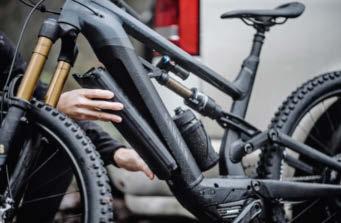
“I was 13 the first time I did a wall ride,” says Kriss Kyle. “I was scared – you’re going so fast you hope your tyres grip, or it’ll hurt. But it gripped, whipped me round and spat me out. I’m still chasing that feeling.” The trick has become one of his signature moves, as seen in the film Kriss Kyle’s Kaleidoscope (2015). In his new movie, Out of Season, the 29-year-old BMX ace enters the Welsh woodlands to perform the manoeuvre on a far heavier vehicle – a mountain bike. “This has been four years in the making,” he says. “I’ve always wanted to build a curved wall ride in the woods.” Here’s how Kyle, ramp builder George Eccleston and the film’s director Matty Lambert achieved this…
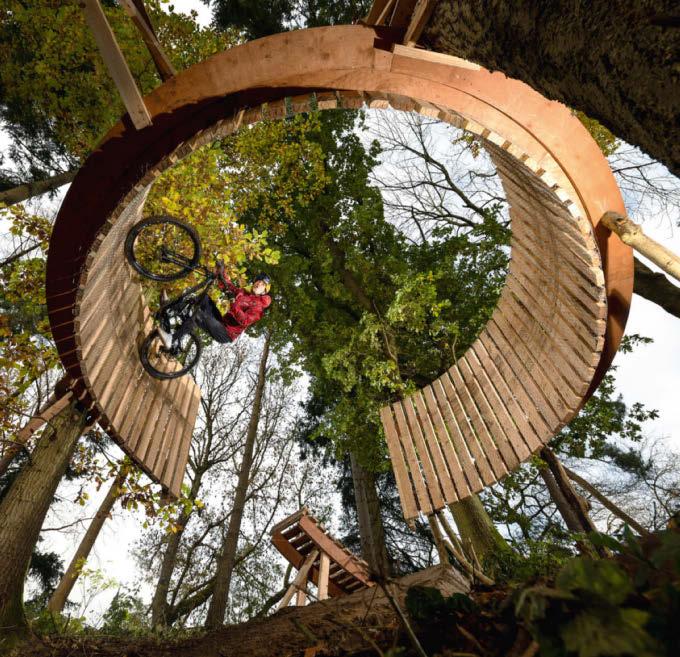
The vision
“I’m always thinking, ‘What’s next?’” says Kyle. “I thought I’d like to do a 270° [wall ride], where I’m going into the wall then sweeping under it on the way out without hitting my head. As long as I can picture it in my head, I know I can do it.”
The plan
“Kriss often just has a rough idea in his head and we try to find a spot that works,” says Eccleston. “We picked a point amid these three trees to get the lateral side-to-side stiffness. We needed trees on a slope that allowed [the wall] to be 1.5m off the ground at the entry point, but 2m on the other side so he could exit beneath it.”
The build
“The shape was pre-cut in the workshop, then assembled on site in two days,” says Eccleston. “We used plywood rings made from birch – it’s flexible yet durable, so we use it on indoor skate builds – and larch slats to provide strength and grip.”
The test
“I was nervous as I wouldn’t get to go on it before it was built,” says Kyle, “so it was a case of stepping into the unknown.” Eccleston says they were
Gripping stuff: BMX ace Kriss Kyle does the rounds on his wall in the Welsh woods
CREATE Land a wall ride
Bike supremo Kriss Kyle reveals the art of creating this incredible move
270°
Degrees of perfection
“The upper circle is 4.2m in diameter, but the lower circle is only 4m as it has a backward lean of 5°,” says Eccleston. “That means if it’s wet on the shoot Kriss can hit the wall slower with more control and grip. If it was vertical, he’d slide straight down it.”
prepared to make alterations on set: “On the first few goes, we had to watch for wobbles when Kriss hit it at a certain point. Where that happened, we added extra timber braces.”
The moment
“We had two angles to film: one from behind, showing Kriss going into the wall ride, then a drone moving down from the tree canopy,” says Lambert. “You want to see him from a riding perspective – to see how hard it is – but it should also look beautiful. It’s quite awkward entering the curved wall, and the viewer can see how thin the gap is. As he hits the wall, he kind of disappears.” Watch Out of Season from April 15 at redbull.com
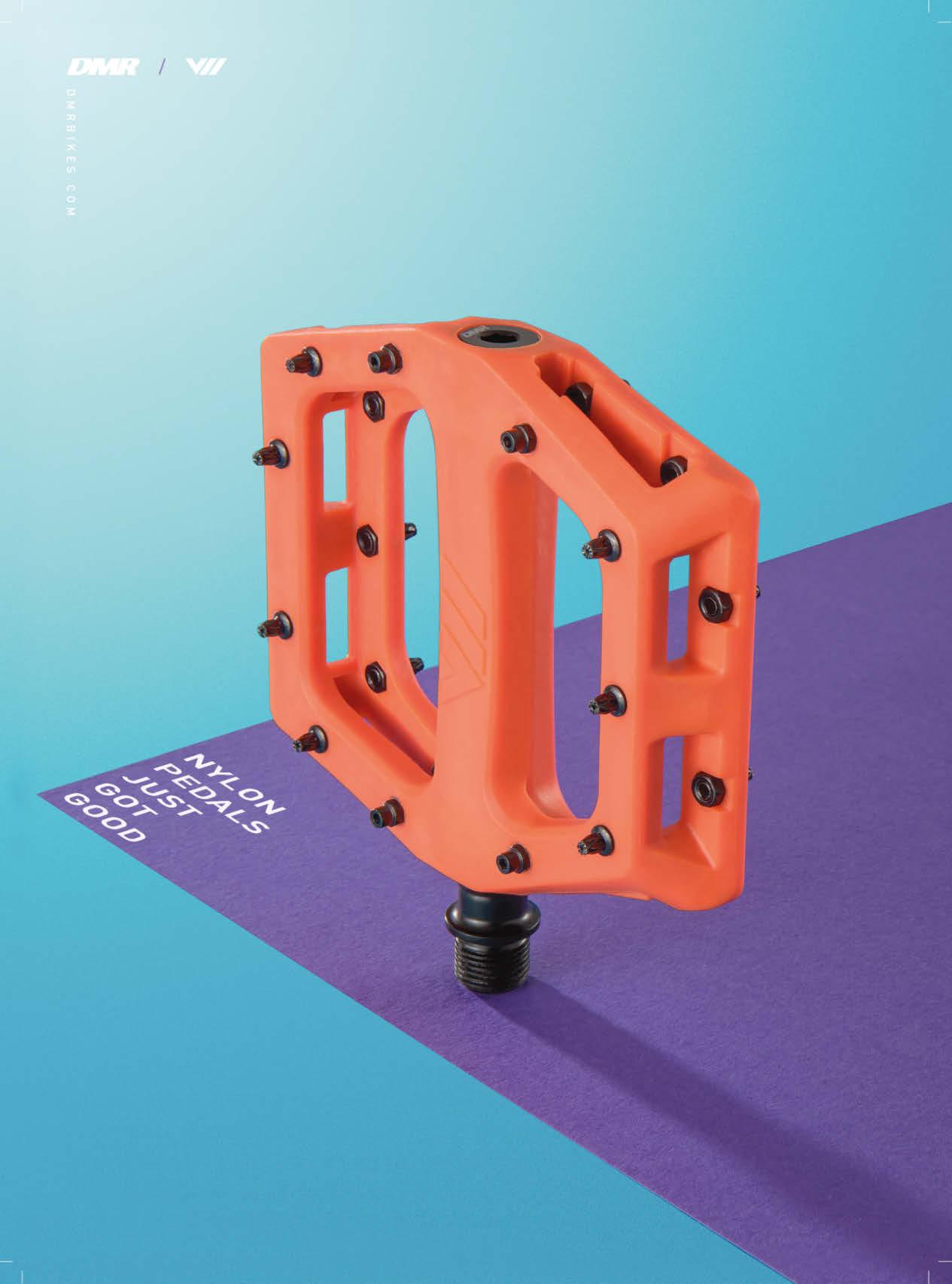
Charge ahead
Gone are the days of electric mountain bikes being labelled as cheating, lazy, or even dull. With professional riders such as Matt Jones and Tahnée Seagrave already jumping on board, it’s time to join the e-revolution...
MARIN’s slogan, etched into the rims, is ‘Made for fun’. Thanks to the motor, it’s enjoyable going uphill, but with a full suspension this bike is clearly built for maximum pleasure on a fast descent.
The trail tamer: Marin Alpine Trail E2

Mountain biking was born in the hills of Marin County, California, in the late 1970s and early ’80s. Among its innovators was Marin Bikes, which, for 35 years, has put its prototypes through their paces on those original tough and gnarly trails. So, when the company claims the Alpine Trail E2 is its “most capable eMTB to date”, that’s no small boast. Based on the non-electric Alpine Trail model, the E2 adds extra zip to a much-loved all-mountain platform with a 250W Shimano STEPS EP8 motor, which flattens steep climbs at the flick of a button. A removable protective plate over the frame-integrated battery adds peace of mind should you end up in the rough stuff. marinbikes.com

Rider #1: The modest mountain man
Not everyone wants to look like a circus tent on two wheels. This is off-road gear for the unassuming rider who wants to stay low-key while trusting that his kit can deliver Left to right, from top: LEATT MTB 2.0 water-resistant and windproof jacket with magnetic hood system for fixing to a helmet, leatt.com; MET HELMETS Bluegrass Rogue Core MIPS helmet, met-helmets.com; DAKINE Sentinel bike gloves, dakine.com; GUSSET S2 pedals, made from precision-engineered 6061 alloy, gussetcomponents.com; ARCADE BELTS Midnighter adventure belt, arcadebelts.com; STANCE Athletic Crew Staple socks, stance.com, GIRO Roust Long-sleeve MTB jersey, giro.co.uk; LEATT 2.0 Flat shoes, leatt.com; TSG Trailz shorts, ridetsg.com; OSPREY Savu 2 two-litre biking lumbar pack, ospreyeurope.com; ENDURA Singletrack Lite Knee Pads II, endurasport.com; EXPOSURE LIGHTS Flex eMTB light with an output of up to 3,300 lumens, and RedEye-E light, exposurelights.com
Rider #2: The woodland warrior
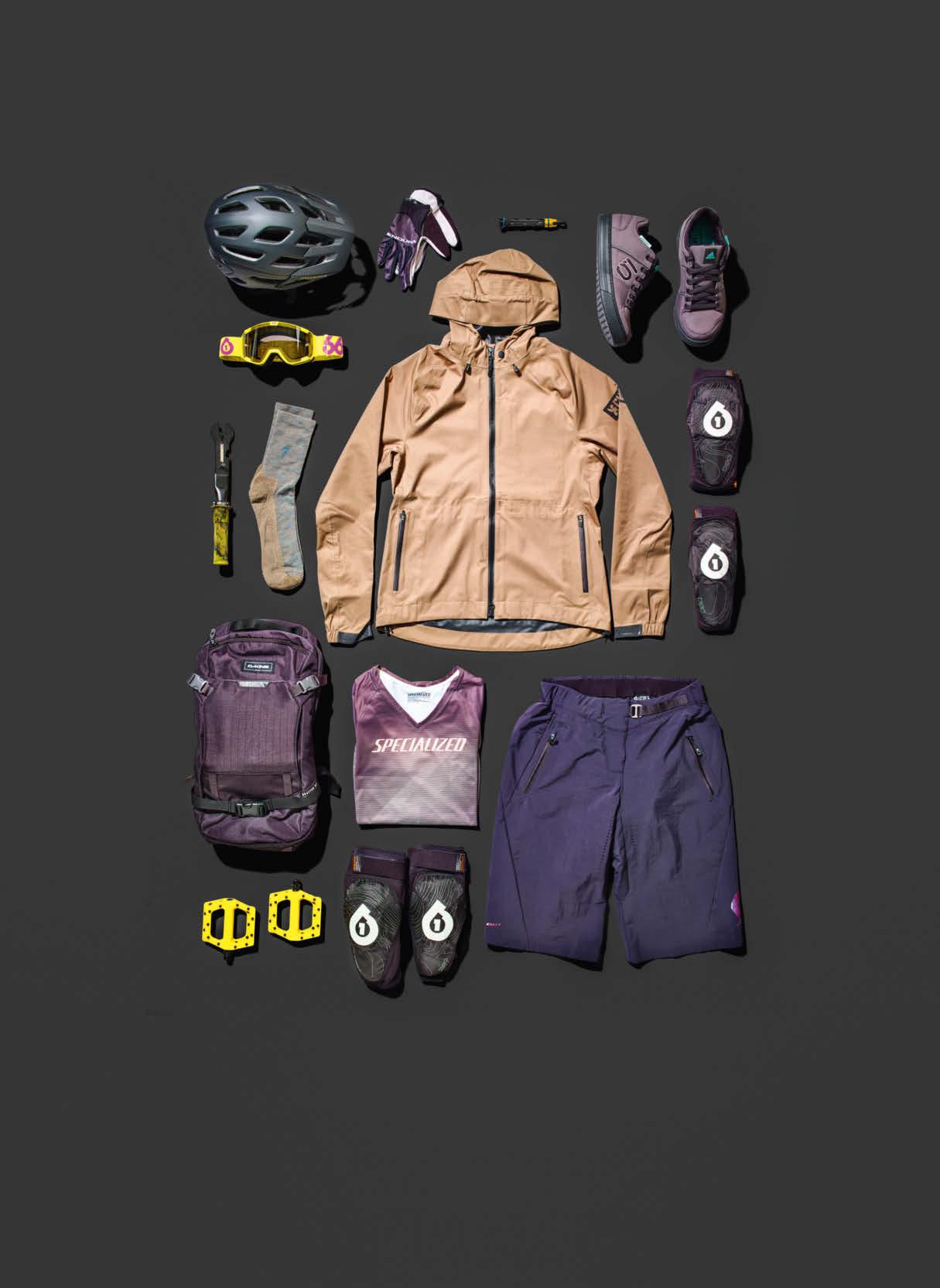
For the female trail rider wanting to blend into the backcountry but still stand out for her skills, here’s a full set of kit that’s all about function and less about frills
Left to right, from top: SPECIALIZED Ambush Comp helmet with ANGI crash sensor, specialized.com; ENDURA Hummvee Lite Icon gloves, endurasport.com; LEZYNE Tool Insert Kit multitool, ride.lezyne.com; ADIDAS Five Ten Freerider Primeblue 2021 MTB shoes, adidas.co.uk; SIXSIXONE Radia goggles, sixsixone.com; DMR BIKES Pedal spanner, dmrbikes.com; SPECIALIZED Techno MTB Tall socks, specialized.com; CHROME Storm Salute Commute jacket, chromeindustries.com; SIXSIXONE DBO elbow pads, sixsixone.com; DAKINE Drafter 14L Bike Hydration backpack, dakine.com; SPECIALIZED Andorra Air Longsleeve jersey, specialized.com; SCOTT SPORTS Trail Contessa Sign Women’s shorts with padding, scott-sports.com; DMR BIKES V11 pedals, dmrbikes.com; SIXSIXONE DBO knee pads, sixsixone.com
The slender steed: Specialized S-Works Turbo Levo SL
One common – and misinformed – belief about eMTBs is that they’re on the chunky side. Your honour, the defence submits the Turbo Levo SL… Despite packing a motor and battery into its trim physique, it weighs just 17.35kg – lighter than some of the portlier pedal-powered mountain bikes. The US manufacturer’s focus was on creating an e-bike that handles exactly like a regular one rather than a bulky, battery-assisted stereotype. It achieves this by combining a ridiculously light-yet-strong carbon-fibre frame with some of the slickest components, engineering a responsive and reactive ride that will have you forgetting it’s carrying a motor at all. It might not be the most powerful e-ride around, but that’s also not what it’s all about. This bike will make you feel like you’re having a good day – that feeling that comes when the climbs are a breeze and you have the energy to do an extra lap of your regular loop – every time you saddle up. specialized.com
To get the most out of this eMTB, download SPECIALIZED’s Mission Control smartphone app, which allows you to tune the power levels, log rides with Strava, and keep an eye on how much battery life is left. Better still, input the distance you’ll be covering and the app will adjust your power usage throughout your journey to ensure you have enough juice in the battery to get home.
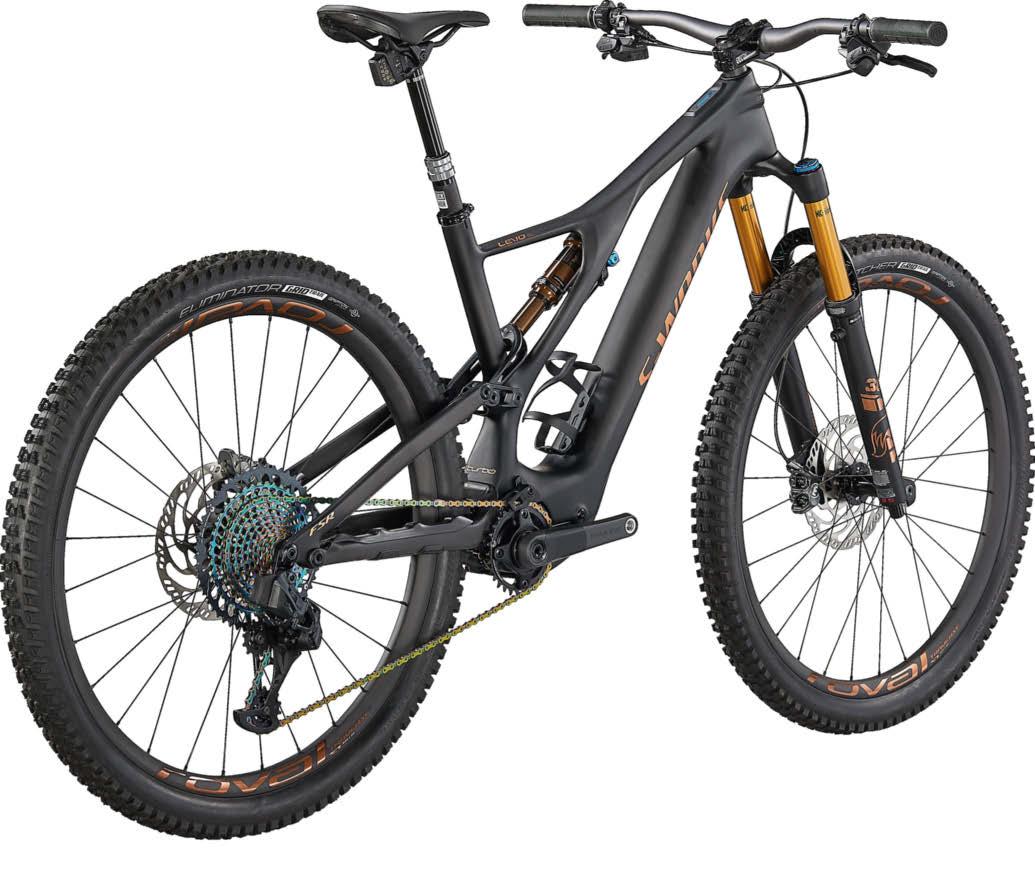
The Turbo Levo SL is lighter than some of the portlier pedal-powered mountain bikes
The downhill demon: Canyon Torque:ON
An electric mountain bike is a serious investment, so, understandably, the thought of throwing it – and you – down a cliff face could prompt you to search for tamer trails. The Torque:ON eliminates these concerns courtesy of a bombproof build. This bike has passed the same strength and impact tests as Canyon’s UCI Downhill World Cup-winning rigs – the first of the German bike brand’s eMTBs to do so – meaning it will pick itself up and dust itself down, hit after hit, even if you struggle to. But being built like a tank doesn’t mean it has to handle like one. The Torque:ON has been designed with agility at its core. Canyon has managed this by integrating a smaller, switchable battery, saving weight without sacrificing any of the fun. Whether you’re tearing down technical descents, stomping juicy jump lines, or even when flying through the air, it feels amazingly weighted. canyon.com
The Torque:ON has passed the same rigorous tests as Canyon’s UCI Downhill World Cup-winning rigs
Boasting 85Nm of power, the Torque:ON is aptly named, but just as much attention has gone into making it a joy to handle. The lighter 504Wh battery improves its centre of gravity, and smaller 27.5in wheels make it more reactive on those tight trails. Deep front and rear suspension gives plenty of traction, and its gravityfocused frame geometry has been designed with fast descents in mind.

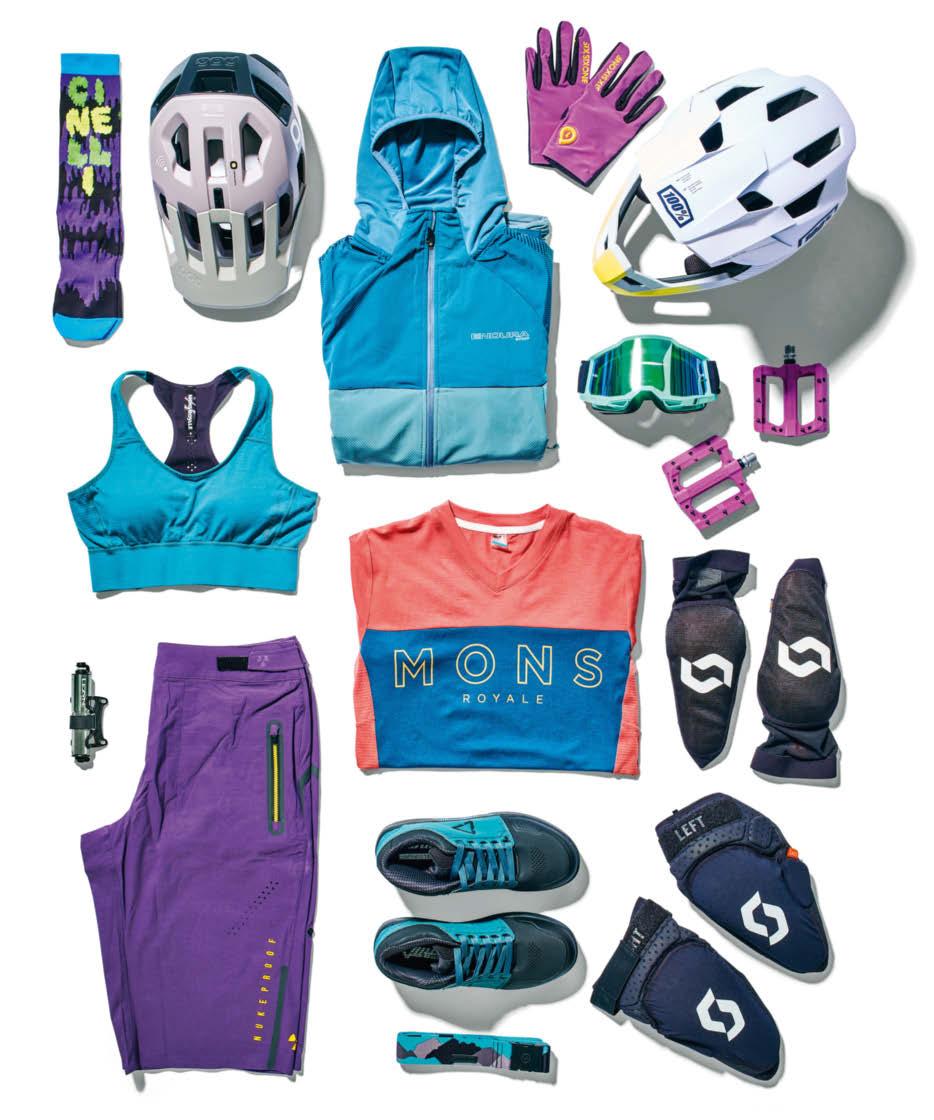
Rider #3: The technicolour trail-rider
For the female rider who isn’t shy about showing off, don’t be afraid to dial up the brightness. And if you’re dialling up the difficulty too, go for the full-face helmet option Left to right, from top: CINELLI Slime socks, designed by Ana Benaroya, cinelli.it; POC Kortal Race MIPS helmet, pocsports.com; ENDURA MT500 Thermal Long-sleeve Jersey II top, endurasport.com; SIXSIXONE Raji gloves, sixsixone.com; 100% Trajecta full-face helmet and Accuri2 moto/MTB goggles, 100percent.com; NUKEPROOF Neutron EVO (Electron EVO) flat pedals, nukeproof.com; MONS ROYALE Stratos Shift bra and Redwood Enduro VT high V-neck tee, monsroyale.com; SCOTT SPORTS Soldier 2 elbow guards, scott-sports.com; LEZYNE Pocket Drive HV compact high-volume bike hand pump, ride.lezyne. com; NUKEPROOF Nirvana shorts, nukeproof.com; LEATT 3.0 Flat shoes, leatt.com; ARCADE BELTS Ranger adventure belt, arcadebelts. com; SCOTT SPORTS Grenade EVO Zip knee guards, scott-sports.com
Rider #4: The firestarter
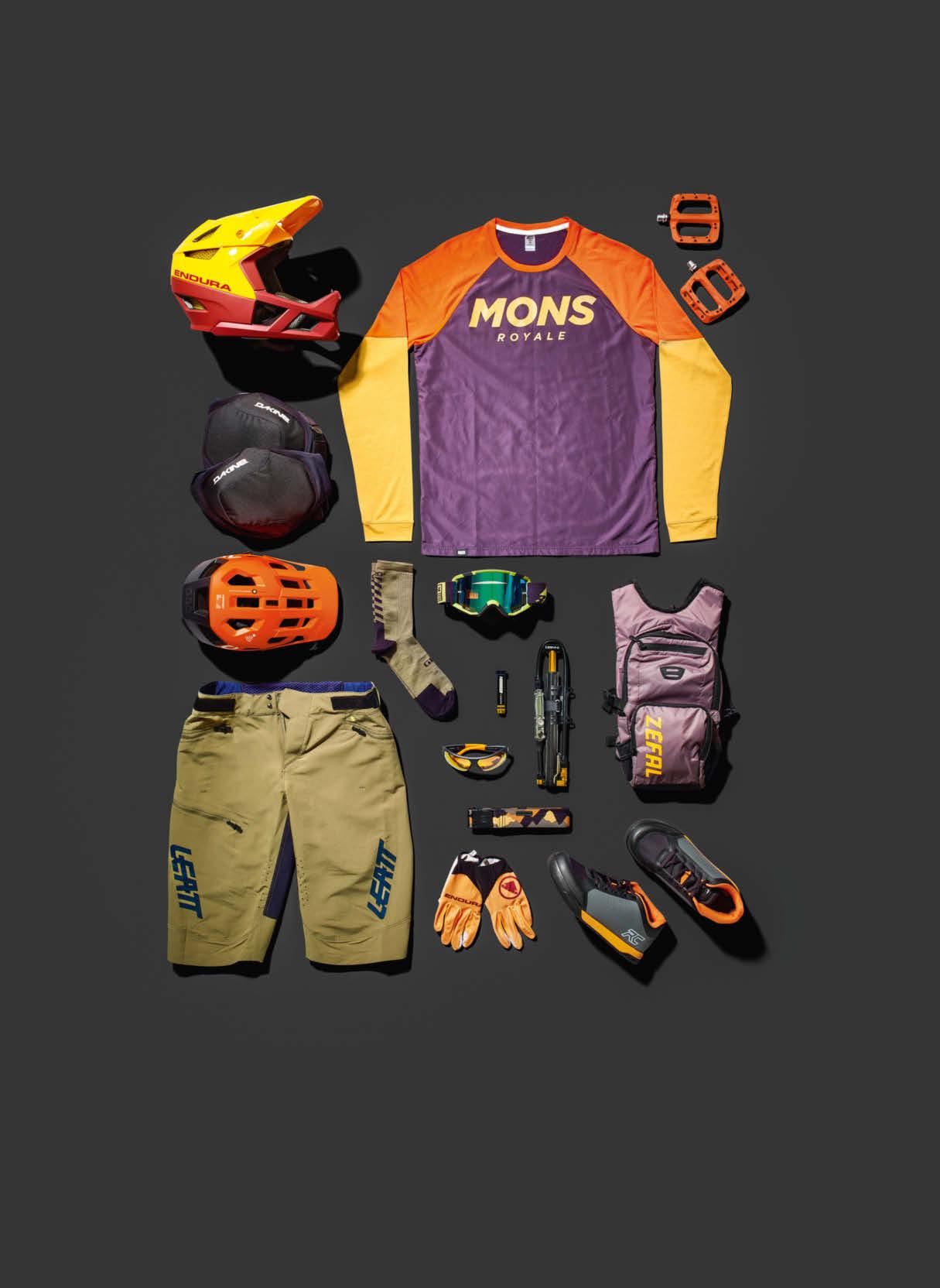
Go bright or go home. A fiery colour scheme for the advanced male rider cruising bike parks or the toughest alpine trails Left to right, from top: ENDURA MT500 Full-face helmet, endurasport. com; DAKINE Agent O/O Bike knee pads, dakine.com; MONS ROYALE Tarn Freeride Long-sleeve Wind Jersey top, monsroyale.com; HT COMPONENTS PA03A pedals, ht-components.com; POC Kortal Race MIPS helmet, pocsports.com; GIRO HRC+ Merino wool cycling socks, giro.com; BELL Descender MTB goggles, bellbikehelmets. co.uk; ZÉFAL Z Hydro XC hydration backpack, zefal.com; LEATT MTB 3.0 shorts, leatt.com; DRAGON Ridge X sunglasses, dragonalliance.com; LEZYNE Micro Floor Drive Digital HVG portable pump and Tubeless tyre repair kit, ride.lezyne.com; ARCADE BELTS Ranger adventure belt, arcadebelts.co.uk; ENDURA Hummvee Lite Icon gloves, endurasport.com; RIDE CONCEPTS Men’s Powerline shoes, rideconcepts.com
The souped-up steal: GT Force GT-E Current
Founded in 1979, GT Bicycles cut its teeth in the pioneering days of BMX, but the brand has come a long way since the era of mullet haircuts, foam crossbar pads and mag wheels, and its current mountain-bike range is renowned for balancing top-of-the-line tech with pocket-friendly prices. The GT-E Current is the “performance-enhancing” version of its all-mountain, full-suspension Force rides, with the race-ready aluminium frame ever-so-slightly beefed up to seamlessly incorporate the battery and Shimano STEPS motor. Strategically mixing high-end components – made by the likes of SunTour and X-Fusion – with own-branded parts means you get a ride that doesn’t cost the earth, but can grow with you and your newfound passion for pinning pumptracks and shredding singletrack. This is a no-nonsense introduction to the world of e-mountain biking. gtbicycles.com
EFI – or ‘electronic fun injection’ – is the technical term that GT has coined for this electric-powered addition to its full-suspension line of mountain bikes. As Belgian downhill enduro pro, GT ambassador and Red Bull athlete Martin Maes likes to refer to it, this bike’s 29in wheels, 150mm of suspension travel and aggressive race geometry make it a very personal chair lift.
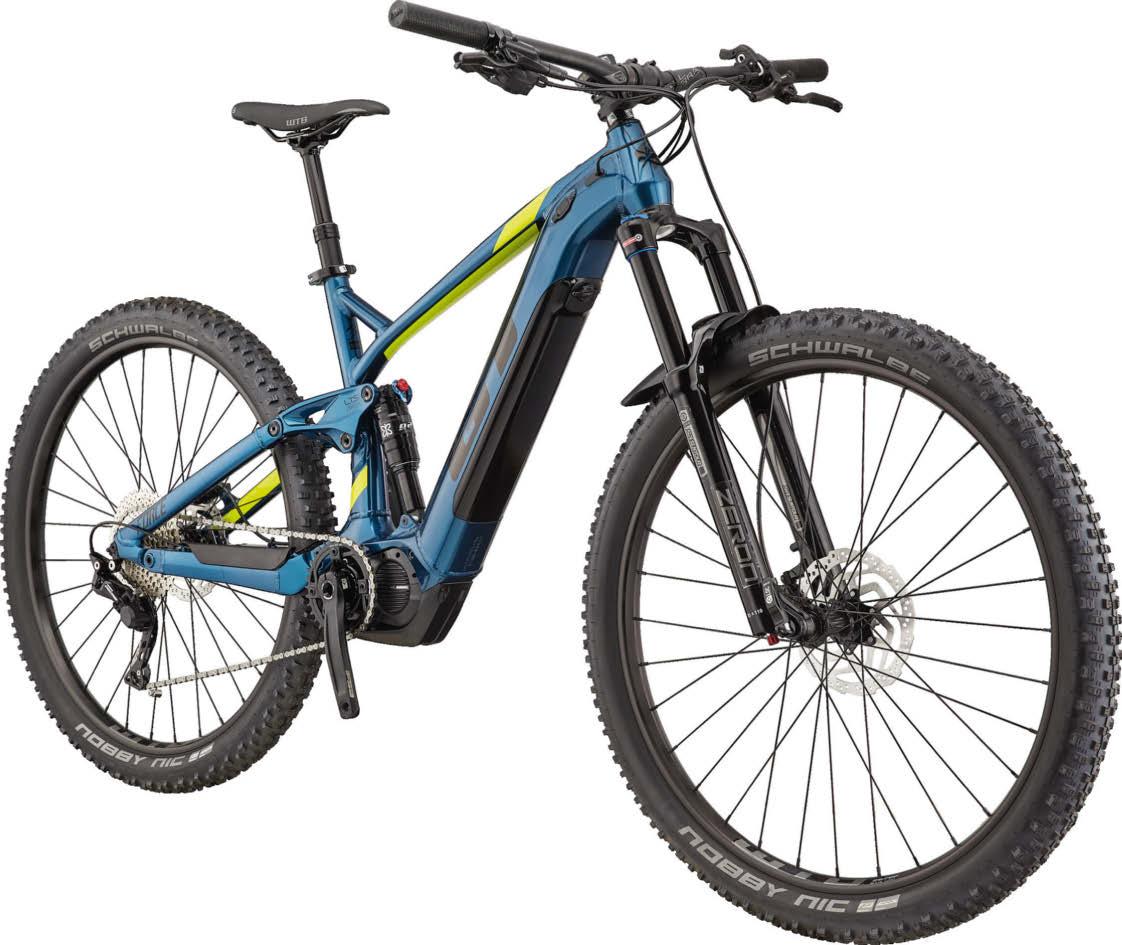
The GT-E Current doesn’t cost the earth, but can grow with your passion for pumptracks
Energetic by nature. Your Energy Bikes.
fazua.com

Before becoming the leading expert on astronaut health and fitness at the German Aerospace Center in Cologne in 2009, Professor Jörn Rittweger conducted research into a seemingly unconnected subject. “Bed-rest studies,” says the scientist. “Subjects lay in bed for 60 days or longer and we’d test training, nutrition and electrical stimulation. It simulates a lot of what happens to astronauts in space, and ultimately it led to me getting this job.”
Going into space is extremely hazardous to health. With no protective atmosphere or magnetic field, exposure to radiation is increased. “On the ISS, [radiation is] 300 times higher than on Earth. On the Moon, it’s 600 times higher.” But the biggest factor – one that relates most closely to the professor’s bed studies – is gravity, or the lack of it. “Gravity is perhaps the strongest environmental stimulus since the start of our evolutionary journey. Our bodies have developed mechanisms to ensure our brains receive enough blood when we’re upright.”
In zero gravity, however, up and down don’t exist. “Within hours, astronauts discharge about a litre of urine to get rid of the blood they’re no longer storing in their legs,” Rittweger says. “Low gravity also knocks the ear’s balance system off, causing nausea. It takes days for the body to suppress this ‘space adaptation syndrome’; astronauts learn to keep their head still and not turn quickly.”
As the head of the centre’s muscle and bone metabolism department, Rittweger’s prime focus is clear. “Of the almost 500 muscles in our body, almost half support standing, walking or running, and muscles only grow and develop strength when they meet resistance,” he explains. With the lack of gravity on the ISS, astronauts aren’t pulled to the ground; there’s no resistance, and muscle atrophy sets in.” The human body, he says, renews around one to two per cent of its muscle mass per day, but in space (or long periods of bed rest) it’s shed rather than gained. And the same happens to your bones: “Leg bones lose about one per cent of their mass per month.”
The solution isn’t simply sending astronauts into orbit bulked up. “We channel calcium through our kidneys. If an astronaut increases bone mass before a trip, they’ll lose more [calcium], which can lead to kidney stones. You don’t want that to happen in space.” There’s also the effect on metabolism: astronauts have higher rates of adult-onset diabetes, meaning an increase in their blood sugar. Blood-fat levels increase, too, and there is a danger of atherosclerosis
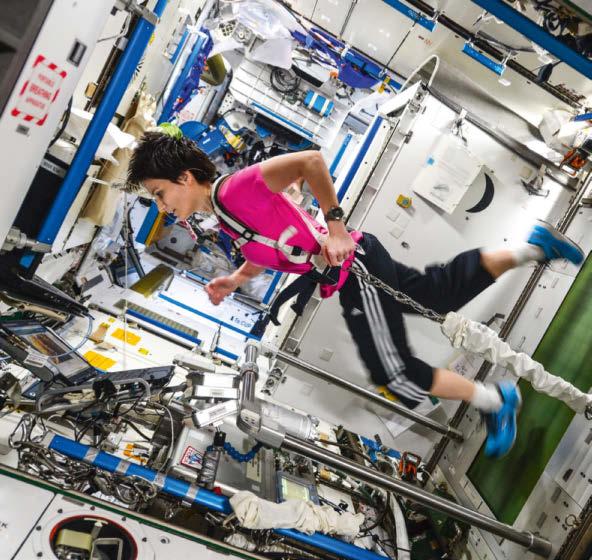
HONE Striving for a celestial body
How does an astronaut maintain an out-of-this-world physique? Here’s the rocket science…
Above: Professor Jörn Rittweger of the German Aerospace Center; top: European Space Agency astronaut Samantha Cristoforetti in training
[plaque build-up on artery walls that can cause blood clots, strokes or heart failure].”
These changes may not cause immediate problems while the astronaut is in space, but they become a real issue once back on Earth. “There are doctors for that,” says Rittweger, “but it would make Mars missions tricky. They could last up to two-anda-half years, and medical care is hard to come by on Mars.” This is why Rittweger and his team have created a comprehensive workout that can be done in space.
The right stuff
“It’s not easy to recreate the important stimulus for our three largest muscle groups – the back extensors, glutes and leg muscles – which account for a third of our body mass,” says Rittweger. This
has led much experimentation. “In the 1970s, the Russians relied on chest expanders; their elasticity generates resistance. Endurance sports were also popular that decade – that’s why we still see the exercise bike and treadmill on the space station. But cycling in space isn’t straightforward – there isn’t the force to keep you in the saddle, and it takes practice to control your upperbody inertia. Astronauts have to be locked to the pedals. It’s more for variety than muscle gain and will probably be culled soon.”
Practicality isn’t the only downside to endurance training. “You also need shockproofing. It would be a disaster if the vibrations damaged the space station. You can’t just drill a lug into the ISS wall, attach a rubber band, and start practising jumps.” As such, spring-based or even robotic dampers are used. “But experts agree that we should now rely on resistance training instead.”
These days, gym junkies on the ISS mainly use a system known as ARED (Advanced Resistive Exercise Device), which uses vacuum tubes and flywheel cables to simulate free-weight exercises such as squats and deadlifts. “Two hours a day, six days a week, as a rule,” says Rittweger. “In the past, fitness was the first thing to bite the dust if time was short. Russian and American doctors have gushed about how astronauts now return to Earth in much better shape.”
Exercising in space is also crucial for mental wellbeing: “Physical exertion generates messenger substances in your muscles such as interleukin-6 or BDNF [brainderived neurotrophic factor]. The former sets the energy balance between the liver and fatty tissue, and we need the latter for the brain. Isolation and a lack of movement change its internal structures responsible for learning and behaviour. That can lead to listlessness, irritation, and lapses in concentration. Sport on the space station can reduce stress. Ernest Shackleton was aware of this.”
Rittweger’s reference to the legendary Arctic explorer, much like his studies into bed rest, are highly pertinent to space travel. “Polar expeditions are some of the most challenging mankind has ever undertaken, and most have gone wrong,” he explains. “Shackleton brought back all of his expedition members alive. We know from his accounts that even in the harshest conditions they went out for an hour’s exercise each day. That’s probably what saved them.”
“Using an exercise bike in space isn’t straightforward” To fitness and beyond
Isolation and cabin fever are standard for an astronaut, but a recent problem for many of us on Earth. These three exercises from European Space Agency fitness expert Nora Petersen will help you stay fit when space is an issue…
The rolling cucumber
Target areas: core and body control Lie face down, legs and arms stretched out, with only your belly touching the floor. Roll onto your back, then onto your belly again, with your limbs outstretched. Adjust reps according to fitness.

Squats with weights
Target areas: legs and core/back Place a barbell on your shoulders and bend your knees, keeping your back straight, knees behind your heels, and maintaining body tension. Adjust the weight and reps to your fitness level.
Rowing leant forward
Target areas: back and shoulders Lift the dumbbell, keeping your back straight as if doing a dead lift. Raise it to your chest while in a forward-leaning position. Keep your elbows close to your body. As with the squats, adjust the weight and reps to your level of fitness.
One giant leap
The professor’s team are always looking for ways of improving astronaut fitness, and the latest involves jumping. “It exercises the entire extensor and flexor chain in the back and legs. We attach the astronaut to a slide that allows freedom of movement but prevents them whacking against the wall. If all goes to plan, we’ll try it on parabolic flights here on Earth in about two years, and on the space station soon after.” Crucially, it needs to be enjoyable: “Imagine being on a flight to Mars and having to find the motivation to work out every morning.”
But no matter how astronaut fitness systems evolve, there’s one side effect that is unlikely to be eradicated. “Sweat,” says Rittweger. “It’s more unpleasant than on Earth because it doesn’t roll down your body. And there’s no post-workout shower, either. You have to clean yourself with Wet Wipes.”

10 ISSUES
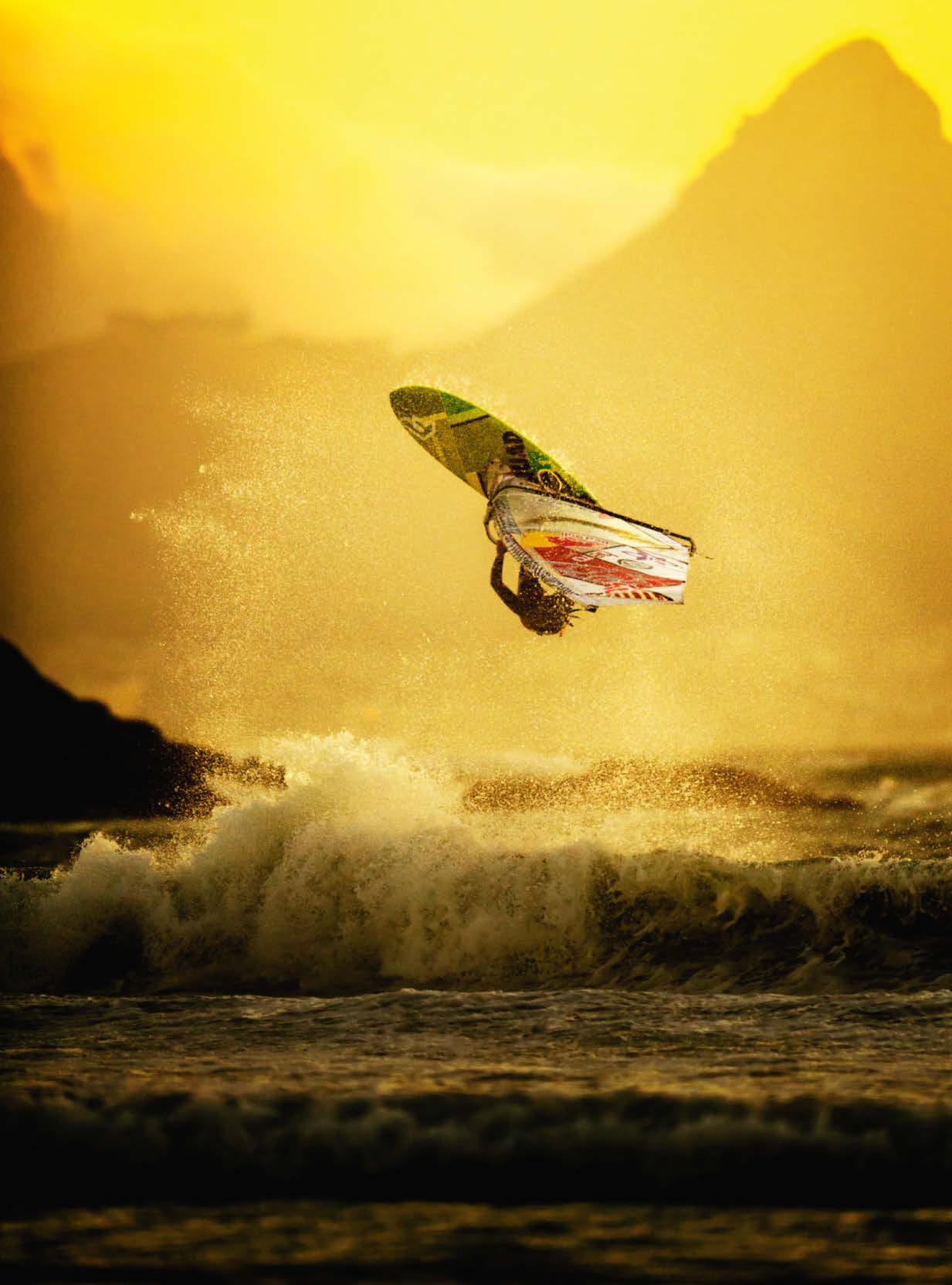
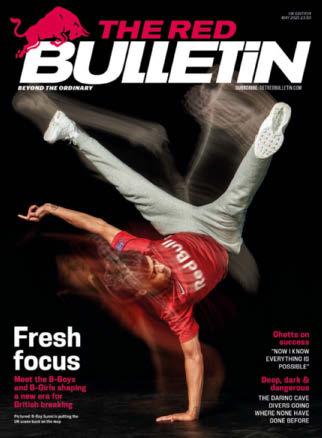
newsstand.co.uk/ theredbulletin £20

BEYOND THE ORDINARY
The next issue is out on Tuesday 11 May with London Evening Standard. Also available across the UK at airports, universities, and selected supermarkets and retail stores. Read more at theredbulletin.com
PLAY Game your career
Playing video games for a living isn’t something a careers advisor would recommend. For that advice, you need a proven esports superstar

Right now, students across the world are studying for a big test, but not the kind you’d expect. Red Bull Campus Clutch is a global esports tournament for universityaged players competing in VALORANT, a tactical teambased first-person shooter. Before it had even launched last year, the first livestreamed playtest broke the record for the most hours of a single game watched in a day (34 million, with 1.7 million concurrent spectators at one point). It has grown into one of the biggest esports, drawing star players from rival games such as Fortnite and Overwatch.
Campus Clutch competitors might not be in the same league, but the winning teams from each country will play off in May’s world final for a prize of €20,000 and a state-of-theart gaming hub for their campus. It might also kickstart a lucrative career they hadn’t previously studied for – pro esports athlete.
Jacob ‘pyth’ Mourujärvi (pictured, right) could teach them a thing or two. The 27-year-old Swede, part of the elite G2 Esports team, is one of the world’s best VALORANT players, but nine years ago he was studying IT at school. “I had no career ideas, but I enjoyed working with computers,” he says. “I learned a lot. Before, I was just shooting and focused on good stats; I didn’t talk a lot. But I became a better team player, more open and honest.” This successful move inspired another one when he left CS:GO. “I was caught in a bad cycle with teams I didn’t believe in. I thought, ‘I’m going to gamble at being one of VALORANT’s best players.’ It was a challenge and it was awesome.”
Sharp shooters: VALORANT characters Phoenix (left) and Jett
He was playing the newly released Counter-Strike: Global Offensive at the time when some fellow players asked him to join a team. “Now I work with computers every day.”
Here are some valuable lessons pyth learned on his unorthodox career path…
Focus your passion
When he left education at 18, Mourujärvi was playing CS:GO for 15 hours a day. “Sleeping at 8am, waking at 5pm and
grinding again,” he recalls. “But when I knew there could be a career in it, I changed my routine and began thinking like a pro. I also stopped shittalking. I’ve been a nice guy for 14 years now.”
Play to your strengths
Pyth is a master of ‘clutch’ play – the ability to turn a game around in the final seconds – which he proved this February when G2 won the first Red Bull Home Grounds competition, and earlier in his career when he singlehandedly defeated rivals Ninjas in Pyjamas in a 2014 four-against-one CS:GO match. Two years later, he was playing for them. “Prove yourself and people will see you,” he says. “But there are no shortcuts – you have to build your way up. And have fun or you’ll get nowhere.”
Exit your comfort zone
In 2015, pyth explored uncharted territory, helping to build new Canadian CS:GO team Luminosity Gaming. “I was teamless and wanted to prove myself,” he says.
Avoid toxicity
“The people who hate on you are the loudest,” says pyth. “Playing CS:GO, I was abused on Twitter and got death threats mid-game. I practised some focusing exercises, but then forgot to do them.” He turned to training software to shut out stress – “I’d practise shooting ranges in [training program] AimLab, with music on to get good vibes” – but the answer lay in a change of scene. “VALORANT has one of the most supportive fanbases,” he says, adding that good workmates are also vital. “In G2, we’re friends in and out of the game.”
Look ahead
At 27, Mourujärvi is an esports veteran. But he’s confident that when his competitive time is up, his career won’t be. “I still want to work in esports, maybe as a coach. A lot of players just practise their aim every day, but they need to understand teamwork and strategy. You can’t just have the same players in the team. It’s like how [Premier League football team] Liverpool became better when they bought [defender] Virgil van Dijk. He’s not an official captain, but he brought leadership and confidence that fed into the team. That’s a good quality to have.” VALORANT is on Microsoft Windows; playvalorant.com. Check out the latest Red Bull Campus Clutch heats at redbull.com. Follow pyth at twitch.tv/pyth






COMPOSE
Beat it up
Don’t be fooled by the toy-like looks – this mini synth packs a Dragon Punch
Modular synthesisers – electronic musical instruments that can be linked to sample, create and manipulate sounds – have been around since the 1950s, when they were as big as a fridge. Street Fighter II, released in 1991, was the first fighting video game to sport ‘combos’ – strings of combat moves. Teenage Engineering is a brain trust of Swedish engineers who make cool, retro-styled music gear, and this is their love letter to all of the above.
Their Pocket Operator synths are a masterclass in stripped-down design: a circuit board with a flipstand, two AAA batteries, and a pair of 3.5mm jacks on the back. On the front is a grid of buttons, two knobs and a mic to create 16 sequences of 16 sounds to record a 256-step tune or perform an impressive live set. Each device has its own sound – rhythm, robot, office – represented by vintage Nintendo-style graphics on the LCD display. Connect them together and you have a digital orchestra. And now you can add SFII’s classic ‘Shoryuken’ samples to that knockout combo. teenage.engineering
Cover your tracks: you can also buy a silicon skin (pictured far left) to protect your Pocket Operator
31

July RED BULL ILLUME 2021
“If you want to be a better photographer, stand in front of more interesting stuff,” veteran Nat Geo lensman Jim Richardson once said. Wise words, as anyone who has contributed to global photography contest Red Bull Illume can attest. This biennial showcase attracts some of the most incredible action-sports and adventure moments captured on film (59,551 images were entered in 2019) then takes them on a world tour (pictured: the 2020 tour stop in Vancouver). Now, 2021’s Image Quest has begun. The submission deadline is July 31, with winners announced in November. redbullillume.com
21
April onwards THE HUNDRED
As spectator events return, it’s set to be a glorious summer, and with the new normal comes new sports. Kicking off on July 21, this 100-ball pro cricket series serves up 68 men and women’s matches across a whole month, with the biggest names taking to the crease, including Ben Stokes (below) captaining Leeds’ Northern Superchargers. Priority tickets went on sale on April 7, with general sales starting April 21. Birmingham, Cardiff, Leeds, London, Manchester, Nottingham and Southampton; thehundred.com

13
April onwards ONE AT A TIME
When it comes to slopestyle MTB, Brett Rheeder is perhaps the greatest there is. The 28-year-old Canadian has four slopestyle world titles, an X-Games gold medal and seven Crankworx victories, but in 2018 he faced one of his toughestever seasons, struggling with a longterm knee injury. Spectators often only see the performance on the day, but this film, following Rheeder through that tumultuous year, is a candid look at the pains an athlete endures for their craft. redbull.com


13
April to late June THE LUNA DRIVE-IN
If there’s one good thing to emerge from social distancing, it’s the revival of the drive-in cinema. But banish throwback images of Grease from your mind; The Luna Cinema delivers state-of-the-art outdoor screens, in-car digital sound and click-and-collect food-and-drink service. Among the films being shown are Wonder Woman 1984 –one of the first chances to see it on a big screen since its December release – Pixar’s Onward, Joker and, of course, Grease. Venues across the UK; thelunacinema.com

13
April to late May THE MERMAID’S TONGUE
Pre-lockdown, you had escape rooms, immersive theatre, and murder mysteries. Now, the latest must-have group experience is the online sleuthing show: a blend of live performance, interactive role-play, team puzzle-solving and taut thriller, played through your computer. Having launched last October with an initial sell-out three-week run, the show has now extended bookings until at least late May. themermaidstongue.com
13
April onwards NATURAL SELECTION: JACKSON HOLE
Travis Rice dreams big. The 38-yearold snowboarder burst onto the competitive scene at the age of 18, with no sponsor, by dropping a gargantuan backside rodeo over a 36m gap at a place called Mammoth Mountain. But his biggest dream was to launch the ultimate backcountry freestyle competition in his hometown. This February, Jackson Hole, Wyoming, saw 24 of the best snowboarders battle across 16 acres of mountain – and, of course, Mother Nature served up large, tipping 1.2m of deep powder on day two. Check out the weekend’s mightiest moments. redbull.com
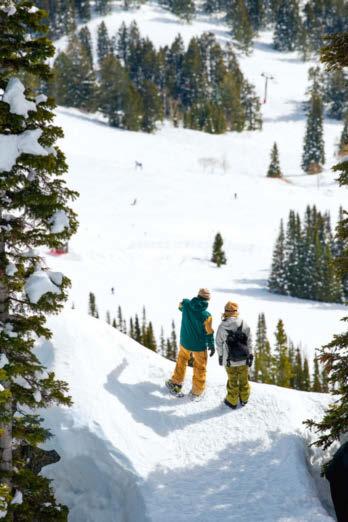
13
April onwards RED BULL BATTALA DE LOS GALLOS 2020
It’s helpful, though not essential, to understand Spanish to gain the most enjoyment from this contest – for a start, you’d already know that the name means ‘Battle of the Roosters’. The world’s biggest freestyle rap competition draws thousands of spectators from across Latin America to witness the crema de crema of Spanish-speaking MCs spitting rhymes. At least, it would most years. For 2020, an audience-free, greenscreen arena was built in the Dominican Republic, so contestants battle amid virtual deserts and mountains. The backdrops are fake, but the lyrics are real. redbull.com
THE RED BULLETIN
WORLDWIDE
The Red Bulletin is published in six countries. This is the cover of our French edition for May, which features the stunning skate photography of New Zealand-born lensman Jake Darwen
For more stories beyond the ordinary, go to: redbulletin.com
The Red Bulletin UK. ABC certified distribution 145,193 (Jan-Dec 2020)
GLOBAL TEAM
Head of The Red Bulletin Alexander Müller-Macheck, Sara Car-Varming (deputy) Editors-in-Chief Andreas Rottenschlager, Andreas Wollinger (deputy) Creative Directors Erik Turek, Kasimir Reimann (deputy) Art Directors Marion Bernert-Thomann, Miles English, Tara Thompson Designers Martina de Carvalho-Hutter, Cornelia Gleichweit, Kevin Goll Photo Editors Eva Kerschbaum (manager), Marion Batty (deputy), Susie Forman, Tahira Mirza, Rudi Übelhör Digital Editors Christian Eberle-Abasolo (manager), Lisa Hechenberger, Elena Rodriguez Angelina, Benjamin Sullivan Head of Audio Florian Obkircher Special Projects Arkadiusz Piatek Managing Editors Ulrich Corazza, Marion Lukas-Wildmann Publishing Management Ivona Glibusic, Bernhard Schmied, Anna Wilczek Managing Director Stefan Ebner Head of Media Sales & Partnerships Lukas Scharmbacher Head of Co-Publishing Susanne Degn-Pfleger Project Management Co-Publishing, B2B Marketing & Communication Katrin Sigl (manager), Mathias Blaha, Katrin Dollenz, Thomas Hammerschmied, Teresa Kronreif (B2B), Eva Pech, Valentina Pierer, Stefan Portenkirchner (communication) Creative Services Verena Schörkhuber-Zöhrer (manager), Sara Wonka, Julia Bianca Zmek, Edith Zöchling-Marchart Commercial Management Co-Publishing Alexandra Ita Editorial Co-Publishing Raffael Fritz (manager), Gundi Bittermann, Mariella Reithoffer, Wolfgang Wieser Executive Creative Director Markus Kietreiber Project Management Creative Elisabeth Kopanz Art Direction Co-Publishing Peter Knehtl (manager), Erwin Edtmaier, Andreea Parvu, Dominik Uhl Commercial Design Simone Fischer, Martina Maier, Alexandra Schendl, Julia Schinzel, Florian Solly, Stephan Zenz Subscriptions and Distribution Peter Schiffer (manager), Marija Althajm, Nicole Glaser, Victoria Schwärzler, Yoldaş Yarar Advertising Manuela Brandstätter, Monika Spitaler Production Veronika Felder (manager), Friedrich Indich, Walter O. Sádaba, Sabine Wessig Repro Clemens Ragotzky (manager), Claudia Heis, Nenad Isailović, Sandra Maiko Krutz, Josef Mühlbacher Finance Mariia Gerutska (manager), Klaus Pleninger MIT Christoph Kocsisek, Michael Thaler Operations Melanie Grasserbauer, Alexander Peham, Yvonne Tremmel Assistant to General Management Sandra Artacker Project Management Gabriela-Teresa Humer Editor and CEO Andreas Kornhofer Editorial office Heinrich-Collin-Straße 1, A-1140 Vienna Phone +43 1 90221-0 Web redbulletin.com Published by Red Bull Media House GmbH, Oberst-Lepperdinger-Straße 11–15, A-5071 Wals bei Salzburg, FN 297115i, Landesgericht Salzburg, ATU63611700 Executive Directors Dkfm. Dietrich Mateschitz, Dietmar Otti, Christopher Reindl, Marcus Weber THE RED BULLETIN United Kingdom, ISSN 2308-5894 Editor Ruth McLeod Associate Editor Tom Guise Chief Sub-Editor Davydd Chong Publishing Manager Ollie Stretton Advertising Sales Mark Bishop, mark.bishop@redbull.com Fabienne Peters, fabienne.peters@redbull.com Printed by Quad/Graphics Europe Sp. z o.o., Pułtuska 120, 07-200 Wyszków, Poland UK Office Seven Dials Warehouse, 42-56 Earlham Street, London WC2H 9LA Tel: +44 (0) 20 3117 2000 Subscribe newsstand.co.uk/theredbulletin Enquiries or orders to: subs@uk. redbulletin.com. Back issues available to purchase at: getredbulletin.com. Basic subscription rate is £20.00 per year. International rates are available. The Red Bulletin is published 10 times a year. Please allow a maximum of four weeks for delivery of the first issue Customer Service +44 (0)1227 277248, subs@uk.redbulletin.com
THE RED BULLETIN Austria, ISSN 1995-8838 Editor Wolfgang Wieser Proofreaders Hans Fleißner (manager), Petra Hannert, Monika Hasleder, Billy Kirnbauer-Walek Publishing Management Bernhard Schmied Media Sales & Partnerships Thomas Hutterer (manager), Alfred Vrej Minassian, Franz Fellner, Ines Gruber, Thomas Gubier, Daniela Güpner, Wolfgang Kröll, Gabriele Matijevic-Beisteiner, Nicole Okasek-Lang, Britta Pucher, Jennifer Sabejew, Johannes Wahrmann-Schär, Ellen WittmannSochor, Ute Wolker, Christian Wörndle, Sabine Zölß
THE RED BULLETIN France, ISSN 2225-4722 Editor Pierre-Henri Camy Country Coordinator Christine Vitel Country Project Management Youri Cviklinski Contributors, Translators and Proofreaders Étienne Bonamy, Frédéric & Susanne Fortas, Suzanne Kříženecký, Claire Schieffer, Jean-Pascal Vachon, Gwendolyn de Vries THE RED BULLETIN Germany, ISSN 2079-4258 Editor David Mayer Proofreaders Hans Fleißner (manager), Petra Hannert, Monika Hasleder, Billy Kirnbauer-Walek Country Project Management Natascha Djodat Media Sales & Partnerships Thomas Hutterer (manager), Alfred Vrej Minassian, Franz Fellner, Ines Gruber, Thomas Gubier, Daniela Güpner, Wolfgang Kröll, Gabriele Matijevic-Beisteiner, Nicole Okasek-Lang, Britta Pucher, Jennifer Sabejew, Johannes Wahrmann-Schär, Ellen WittmannSochor, Ute Wolker, Christian Wörndle, Sabine Zölß
THE RED BULLETIN Switzerland, ISSN 2308-5886 Editor Wolfgang Wieser Proofreaders Hans Fleißner (manager), Petra Hannert, Monika Hasleder, Billy Kirnbauer-Walek Country Project Management Meike Koch Commercial & Brand Partnerships Manager Stefan Bruetsch Advertising Sales Marcel Bannwart (D-CH), marcel.bannwart@redbull.com Christian Bürgi (W-CH), christian.buergi@redbull.com Goldbach Publishing Marco Nicoli, marco.nicoli@goldbach.com
THE RED BULLETIN USA, ISSN 2308-586X Editor-in-Chief Peter Flax Deputy Editor Nora O’Donnell Copy Chief David Caplan Publishing Management Branden Peters Media Network Communications & Marketing Manager Brandon Peters Advertising Sales Todd Peters, todd.peters@redbull.com Dave Szych, dave.szych@redbull.com Tanya Foster, tanya.foster@redbull.com
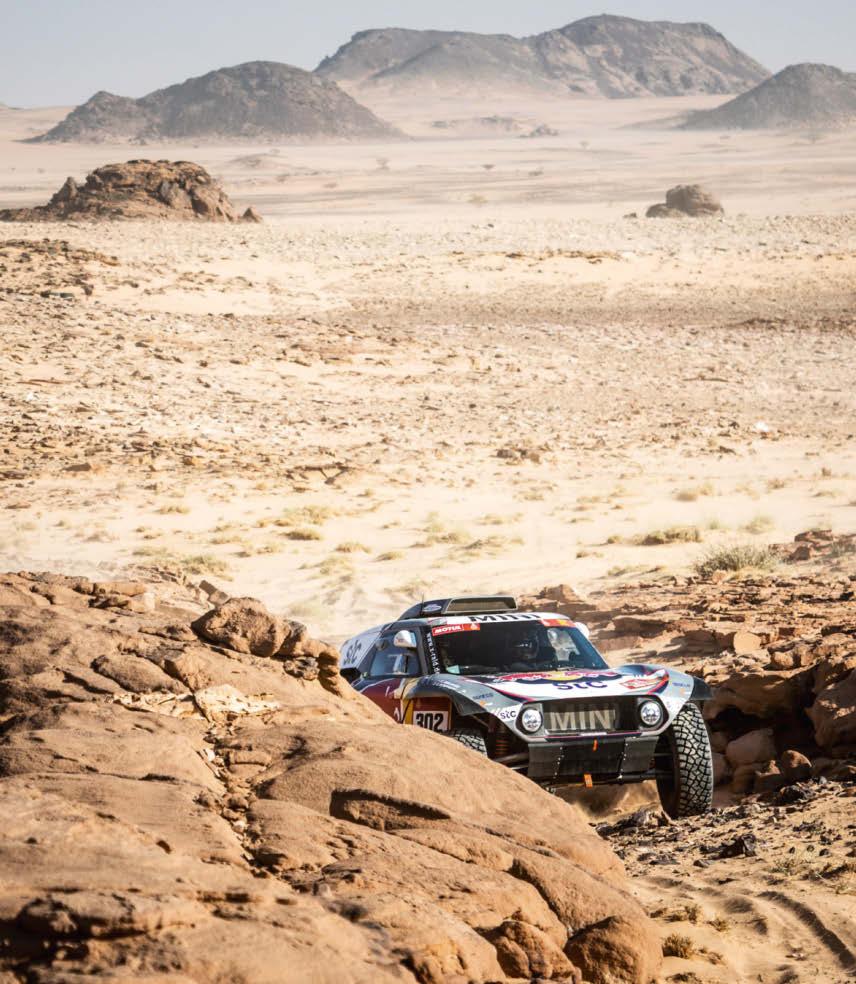
Done and dusted
After his 14th victory in the world’s most legendary rally raid, French driver Stéphane Peterhansel (pictured here during stage three this January) could officially change his name to ‘Mr Dakar’. But then, it’s probably not worth the passport hassle, what with all the international travel he has to do. Africa, South America, Saudi Arabia... the 55-year-old has conquered them all at Dakar. See him in action at redbull.com
The next issue of THE RED BULLETIN is out on May 11
